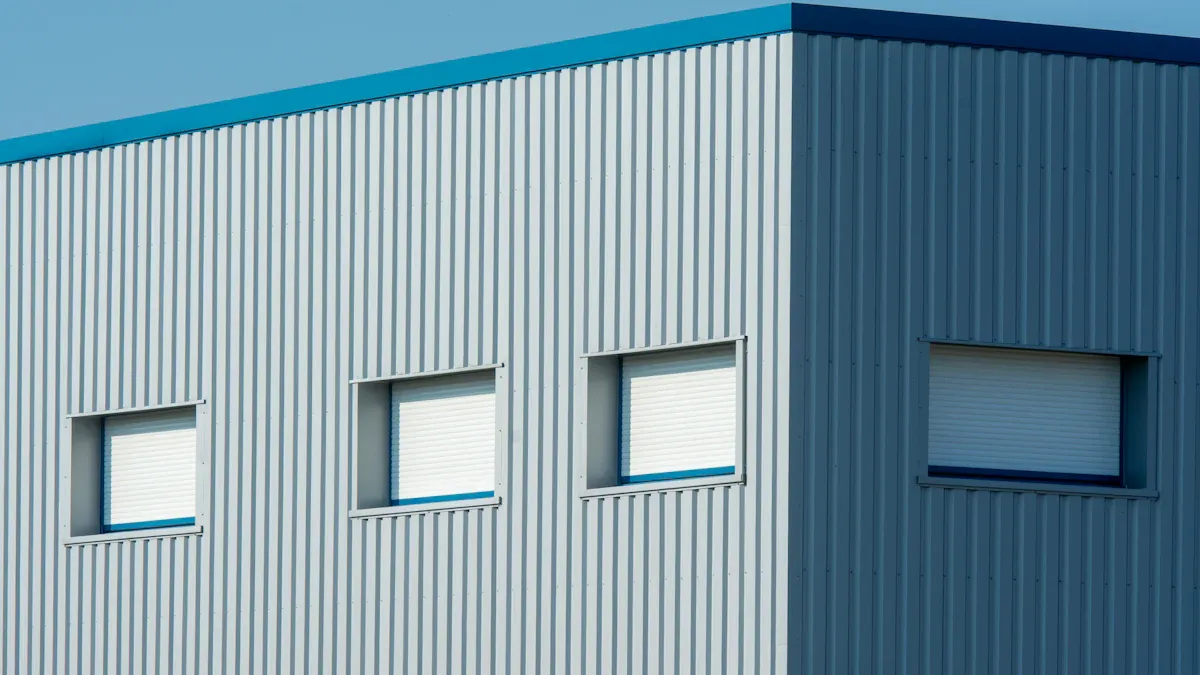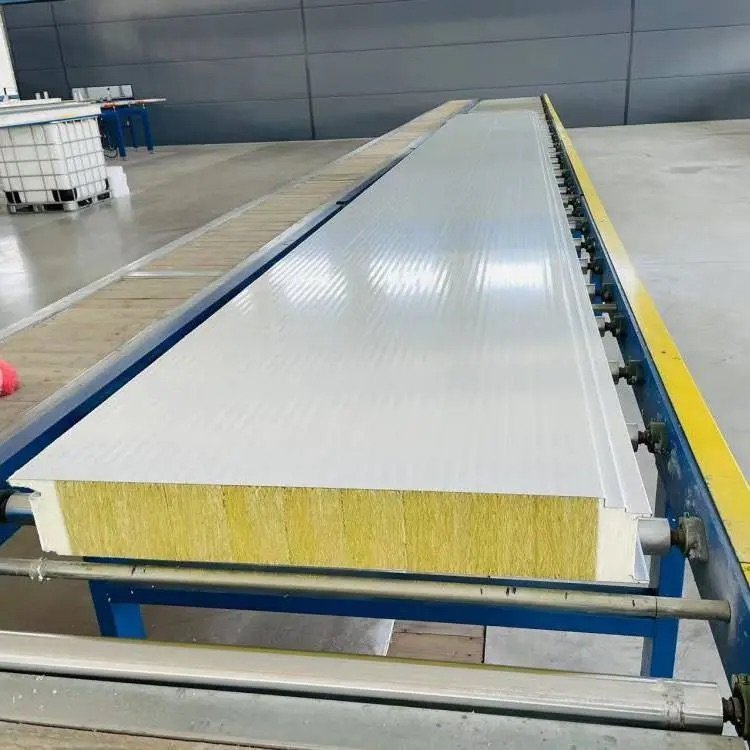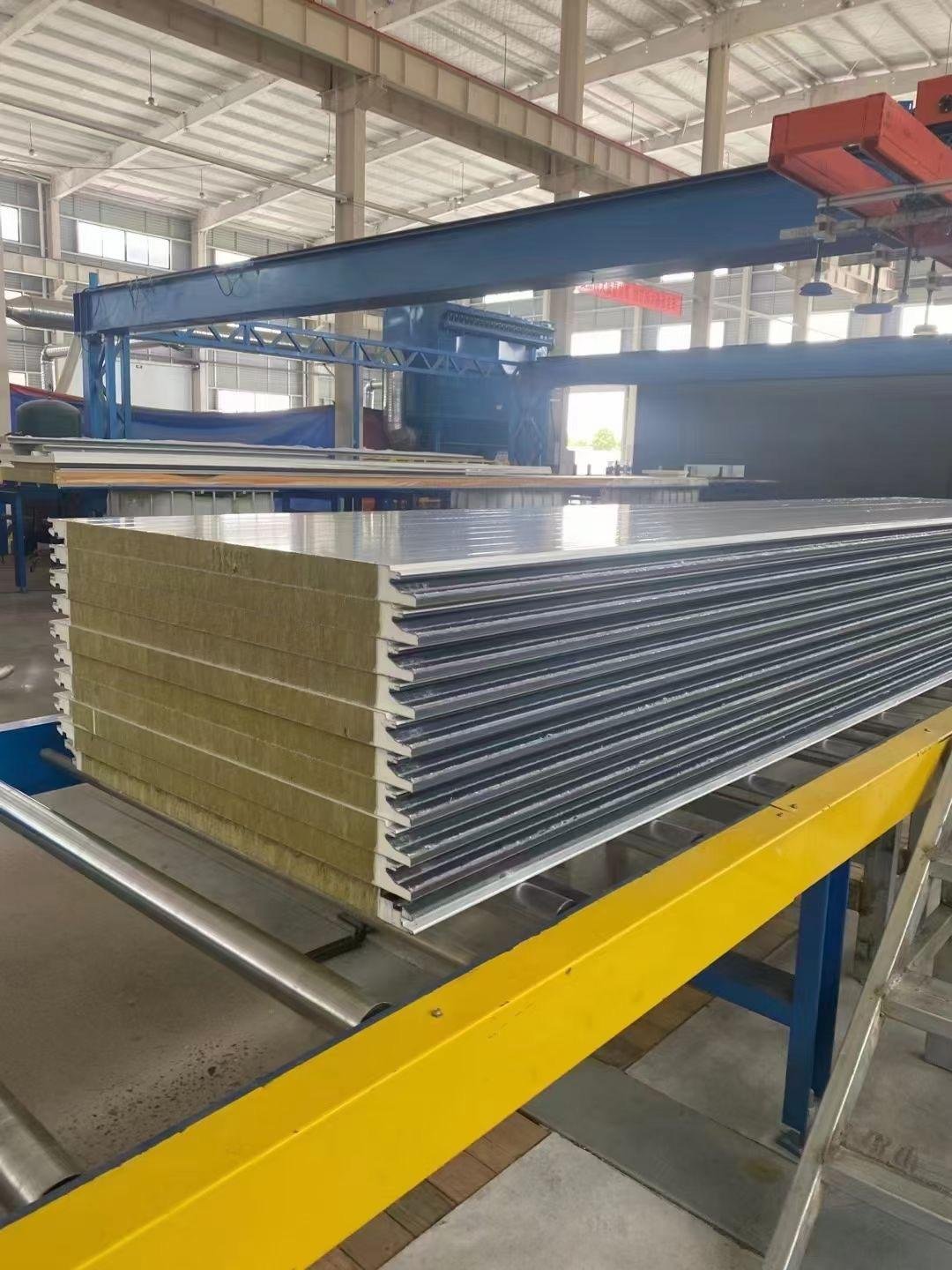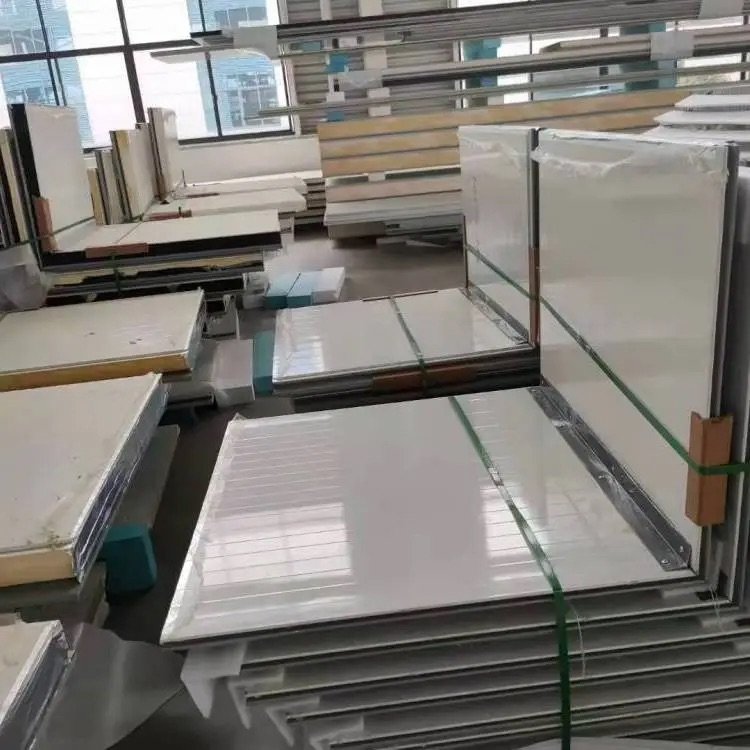
You might wonder how buildings save energy and block noise. The secret is often sandwich panels, which provide excellent thermal insulation. These panels have two metal layers and an insulating middle. This design helps keep heat and sound out. Studies show they block heat 3–6 times better than glass wool. They also reduce noise by 7–8 dB, which is great for loud places. A good sandwich panel can save 70% of energy during a building’s life. This makes them very useful in construction.
Key Takeaways
Sandwich panels keep heat out 3–6 times better than glass wool. This helps save energy at home or work.
The middle materials, like foam and rock wool, cut down noise. This makes them great for homes or loud places.
Picking the right thickness and material strength improves how well they insulate. This keeps spaces comfy and saves energy.
Installing them correctly is very important. Gaps can make them work less, so hire good workers.
Sandwich panels are useful for homes, factories, and special projects. They are a smart pick for building needs.
What Are Sandwich Panels?
Structure and Composition
Outer Layers: Materials and Purpose
The outer parts of a sandwich panel act as shields. These layers are often made of steel, aluminum, or strong plastic. Their main job is to add strength and protect the middle layer. Some panels use special foils and silica powder to keep heat out. These outer layers also fight rust and bad weather, helping them last longer.
Core Layer: Role in Insulation
The middle layer is the most important part. It controls how well the panel blocks heat and sound. Common materials for this layer are PUR, PIR, and rock wool. For example, PUR foam, which weighs 40 kg/m³, keeps heat from passing through. Some panels use advanced materials like vacuum panels or aerogel for better results. This layer stops heat and noise, making the panels great for saving energy and reducing sound.
Key Benefits of Sandwich Panels
Lightweight and Durable
Sandwich panels are light and easy to move. This makes them simple to install without big machines. Even though they are light, they are very strong. They can handle bad weather and heavy loads, so they work well in many places. Their strength means less fixing is needed over time.
Versatile for Various Applications
You can use sandwich panels in many different places. They are great for homes, factories, and even vehicles. They save energy by keeping heat in or out. They also block noise, which is helpful in loud areas. Plus, they are quick to set up, saving time and money on building projects.
Core Materials and Their Insulation Properties

Polyurethane (PU)
Thermal Insulation Properties
Polyurethane is great for keeping heat in or out. Its foam core, weighing 40 kg/m³, blocks heat well. This is because it has low thermal conductivity. It keeps warmth inside during winter and outside in summer. Panels with staggered connectors improve insulation even more. They can reach a thermal resistance of 2.48 m²K/W. This makes polyurethane perfect for saving energy in buildings.
Acoustic Insulation Capabilities
Polyurethane also helps reduce noise. It makes indoor spaces quieter by blocking sound. Adding soft foam or damping materials can improve this further. This makes it useful for places needing both heat and sound control.
Rock Wool
Fire Resistance and Thermal Performance
Rock wool is great for fire safety. It can handle high heat without breaking down. It also traps air in its fibers, stopping heat transfer. This keeps indoor temperatures steady. Its insulation is as good as advanced materials like vacuum panels. These materials block heat 3–6 times better than older options.
Superior Sound Absorption
Rock wool is excellent at absorbing sound. Its dense fibers trap noise, making spaces quieter. It’s often used in factories and offices where soundproofing is needed. With fire safety, heat control, and sound absorption, rock wool is very versatile.
Polystyrene (EPS and XPS)
Cost-Effective Thermal Insulation
Polystyrene is a cheaper option for insulation. It comes in two types: EPS and XPS. It’s lightweight and affordable, making it great for tight budgets. While it doesn’t insulate as well as polyurethane or rock wool, it works fine for many uses. It’s common in homes and offices where cost matters most.
Limitations in Acoustic Performance
Polystyrene isn’t great at blocking noise. Its hard structure doesn’t absorb sound like rock wool does. For noisy areas, you might need extra soundproofing materials. This way, you can balance cost with both heat and noise control.
Glass Wool
Great for Blocking Noise
Have you ever noticed how quiet some places are, even in loud areas? This quietness is often because of glass wool. Its tiny fibers catch sound waves, cutting down noise. That’s why it’s used in offices, theaters, and homes. Glass wool panels soak up sound, making rooms peaceful. If you need something good for both heat and noise, glass wool is a great pick.
Keeps Heat In or Out
Glass wool also works well to stop heat from moving. Its fibers trap small air pockets, slowing heat transfer. This keeps rooms comfy, no matter the weather outside. With its strong heat resistance, glass wool helps save energy. You can use it in walls, roofs, or ceilings to keep temperatures steady. Its flexibility and performance make it a favorite for energy-saving buildings.
PIR (Polyisocyanurate)
Better at Stopping Heat
PIR, short for polyisocyanurate, is amazing at keeping heat in or out. Its stiff foam center blocks heat, making it very effective. PIR panels are usually 100–150 mm thick, saving material and money. These panels help buildings use less energy and lower carbon emissions. For example:
PIR panels keep indoor temperatures steady, cutting energy use.
They are thinner, which lowers shipping and setup costs.
Many PIR panels meet FM Global safety rules, proving they work well.
Strong Against Fire and Long-Lasting
PIR is great at resisting fire and lasts a long time. It can handle heat up to 350ºC, better than materials like PUR. PIR foam stops burning on its own, so it doesn’t spread fires. This makes it perfect for safe insulation. PIR panels also survive tough weather, staying strong for years. FM Global certifies them as safe for fires and hurricanes.
Feature | Details |
|---|---|
Core Material | Hard, eco-friendly, self-extinguishing PIR foam |
Thermal Insulation Properties | Excellent at stopping heat, allowing thinner panels and saving money |
Fire Safety Certification | FM Approved, meeting strict fire safety standards |
Environmental Durability | Built to handle tough conditions, lasting a long time |
PIR’s mix of heat control, fire safety, and strength makes it a top choice for modern buildings.
Factors That Affect Insulation Performance
Panel Thickness
How Thickness Helps With Heat
The thickness of a panel is very important. Thicker panels stop heat from moving between inside and outside. A test used a Hot Box tool to check heat flow in panels. It showed that thicker panels block heat better. Computer tests also proved this, showing thicker panels save energy. When picking panels, choose the right thickness for good insulation.
How Thickness Helps With Noise
Thicker panels also block more noise. They soak up sound waves, making spaces quieter. This is useful in noisy cities or factories. Picking the right thickness can make rooms peaceful and comfortable.
Material Density
How Density Affects Insulation
The core material’s density changes how well it insulates. Dense materials like rock wool block heat and sound better. Lighter materials like EPS cost less but don’t work as well in loud places. The table below shows what studies found about material and insulation:
Study | What It Found |
|---|---|
Gervásio et al. (2010) | Insulation materials help save energy. |
Carbonari et al. (2013) | EPS panels are good for heat control. |
Bush & Stine (1994) | Truss connectors change how panels insulate. |
Lee & Pessiki (2008) | Tested how well insulated wall panels work. |
Installation Quality
Why Good Installation Matters
Even great panels won’t work well if installed badly. Gaps or loose fits let heat and sound pass through. This lowers the panel’s performance. Proper installation keeps panels tight and effective. Always hire skilled workers to get the best results from your insulation.
Environmental Conditions
How Temperature and Humidity Affect Performance
Weather, like heat and humidity, changes how panels work. Extreme weather can make it harder for panels to block heat or sound. When it’s very hot or cold, the materials inside react differently. This can affect how well they insulate.
Temperature changes impact how panels stop heat. In tests, panels were put in rooms with different temperatures. One room was cold (19–20 °C), and the other was hot (70–75 °C). Some panels, like Panel P4, kept a big temperature difference. This means they blocked heat better. But control samples (P0) showed small differences, meaning more heat passed through. This shows that the design and materials of a panel matter a lot in different temperatures.
Temperature Condition | Result Description |
|---|---|
19–20 °C (Cold Room) | Took 600–1000 minutes to reach steady conditions. |
70–75 °C (Hot Room) | Hot temperature range reached in the test chamber. |
Control Sample (P0) | Small temperature differences, meaning more heat passed through. |
Panel P4 | Big temperature difference, meaning less heat passed through. |
Humidity also affects how panels work. High humidity can let water into the panel’s core if not sealed well. This lowers their ability to block heat and can damage them over time. Materials like polyurethane and PIR resist water better, so they’re good for wet places.
To make panels work best, pick ones made for your weather. Installing them correctly and sealing them tightly helps protect them. This keeps your building comfy and saves energy.
Practical Applications of Sandwich Panels

Residential Buildings
Energy-Efficient Homes
Sandwich panels help make homes save energy. Their middle layer, often made of polyurethane foam, stops heat from moving in or out. This keeps indoor temperatures steady and reduces the need for heaters or air conditioners. Using these panels lowers energy bills and helps the environment. Studies show they block heat leaks, cutting energy use and carbon emissions.
Saving energy is important to lower costs and protect the planet. Sandwich panels keep homes comfortable and are great for eco-friendly housing.
Noise Reduction in Urban Areas
Cities can be noisy with traffic and construction sounds. Sandwich panels help make homes quieter. Their core materials, like glass wool and rock wool, absorb sound waves. This makes them perfect for homes in busy areas, giving families peace and quiet indoors.
Industrial and Commercial Spaces
Temperature-Controlled Environments (e.g., Cold Storage)
Industries like food storage need spaces with steady temperatures. Sandwich panels with polyurethane foam cores are great for keeping cold air inside. They stop heat from entering, protecting sensitive items like food and medicine. These panels are easy to install, saving time during building projects.
Benefits for Cold Storage:
Blocks heat well.
Lightweight but strong.
Resists water and bad weather.
Soundproofing in Factories and Offices
Factories and offices can be loud places. Sandwich panels with dense cores, like rock wool, absorb noise well. They make workspaces quieter and more productive. In 2023, walls and floors made with these panels were very popular, earning 53.96% of revenue in commercial spaces.
Application Segment | Revenue Share (2023) | Projected CAGR (2024-2030) |
|---|---|---|
Walls and Floors | 53.96% | 7.6% |
Non-residential | 58.5% | Highest growth rate |
Specialized Applications
Transportation (e.g., Refrigerated Trucks)
Sandwich panels are key for refrigerated trucks. Their lightweight design and strong insulation keep goods cold during travel. Aluminum outer layers and polyurethane foam cores make them durable and reduce truck weight. This saves fuel and lowers costs.
Modular Construction and Prefabricated Structures
Prefabricated buildings use sandwich panels to build faster and cheaper. These panels cut labor costs and waste, making them eco-friendly. Cities are using more modular buildings, increasing demand for sandwich panels.
Why Prefabrication Works Well with Sandwich Panels:
Quick assembly saves time.
Lightweight panels are easy to move.
Strong materials last a long time.
Sandwich panels are great for keeping heat and noise out. Their middle layers, like polyurethane and rock wool, help save energy and block sound.
Picking the right material and thickness makes them work best.
Using sandwich panels makes spaces comfy and energy-saving. They are perfect for homes, offices, and special uses. These panels last long and are good for the planet.
FAQ
1. What are sandwich panels used for?
Sandwich panels keep buildings, vehicles, and modular structures insulated. They help control indoor temperatures and block noise. You can see them in homes, offices, factories, and cold storage areas.
2. Which core material is best for soundproofing?
Glass wool and rock wool are great for blocking noise. Their thick fibers trap sound waves really well. If you want quiet rooms, these are the best options.
3. How do sandwich panels save energy?
Sandwich panels stop heat from moving in or out. This keeps indoor spaces at a steady temperature. They lower the need for heaters or air conditioners, saving energy and cutting costs.
4. Are sandwich panels eco-friendly?
Yes, many sandwich panels are made with green materials like PIR foam. They use less energy and last a long time, reducing waste. Picking the right panel helps make your building more eco-friendly.
5. Can sandwich panels handle extreme weather?
Yes, sandwich panels with strong outer layers and water-resistant cores work well in tough weather. Materials like PIR and polyurethane resist water and temperature changes, lasting for years.







